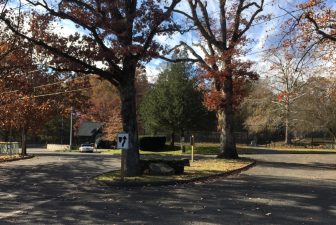Town officials are weighing a proposed parking and traffic plan for Mead Park that would preserve its one-way entrance and exit while making other major changes to how and where motorists can go and pull in.

Plans call for removing the tree pictured at the right here and reconfiguring the traffic island in Mead Park so that it’s more intuitive for motorists to stay right. Credit: Michael Dinan
Under a proposal from local landscape architecture firm Keith E. Simpson Associates, traffic in the first long area that motorists enter from Park Street would become two-way, while the often-disregarded traffic island in the center of the park would be re-shaped so that it’s more intuitive to motorists, and new curbing would come to a second traffic island near the Apple Cart at Mead Park Lodge so that nobody parks directly on top of it.
During a Nov. 8 presentation to the Parks & Recreation Commission, the firm’s Bill Pollack said it was possible to have 90-degree parking for the long stretch along the pond, though some officials said they’d prefer to have more comfortable angled parking there, even if it means losing some spaces.
Commissioner Francesca Segalas said she would prefer angled parking because it’s far easier to open a front door “because the front of the next car is not even next to you.”
The proposal also calls for new parallel parking spaces beyond the right-field wall of the large baseball field, new directional arrows on the pavement and crosshatched areas between newly designated handicapped spaces and fire lanes.
Commission Chair Sally Campbell asked Parks & Rec member to visit Mead and consider the proposed changes prior to the group’s next meeting.
Central to the plan is re-shaping the traffic island in the middle of Mead so that motorists driving toward the little league baseball fields stay right—as instructed by a sign on the island—as opposed to cutting left.
The area is “a bit of a mess,” Pollack said.
“There is an existing island that sort of points you in the direction to exit the park which really inhibits the flow of the park, so we reconfigured that,” he said. “There is a monument there, stay there in middle of island, one tree is in pretty good shape, and there is another existing tree on this end that is not doing well. We would take it out, which allows us to rebuild the island.”
Some commissioners said they did not favor the idea of making area between the large baseball field and pond two-way, in part because it could make people think they can exit onto Park Street. Others said that those who arrive at Mead during very busy times—for example, when all the ball fields are in use for games—simply need to pull out at Richmond Hill Road and drive back around.
Keith Simpson, head of the firm, said part of the idea behind making that section two-way is to give motorists who do not find a space on their first pass-through a second chance.
Recreation Director Steve Benko said the entrance at Park Street used to be two-way until the late-1970s, when “numerous accidents” prompted town officials to make a chance.
He added that many people do not park along the right-field line of the big baseball field during games because foul balls often crash into windshields there. Changing that area to parallel parking might be a better option, commissioners said, even if it meant losing some spaces.
Commissioner Laura Costigan recommended looking again at three newly designated handicapped parking spaces along the large field’s first-base line “because that is worst spot if a baseball game is happening—the [foul] balls go right there.”
One goal of the new plan is to improve traffic flow around the second traffic island near the little league fields, where parents often go for the most direct access to the children’s playground there, as well as the Apple Cart.
Commissioner Katie Owsley said that in many cases, parents with multiple young children will seek to park as close as possible to the little league fields and playground, regardless of signage or designated parking spots.
“If you have small kids and you are trying to park near the Apple Cart and everyone is crying, all bets are off,” she said.
The commission is scheduled to meet Dec. 6.